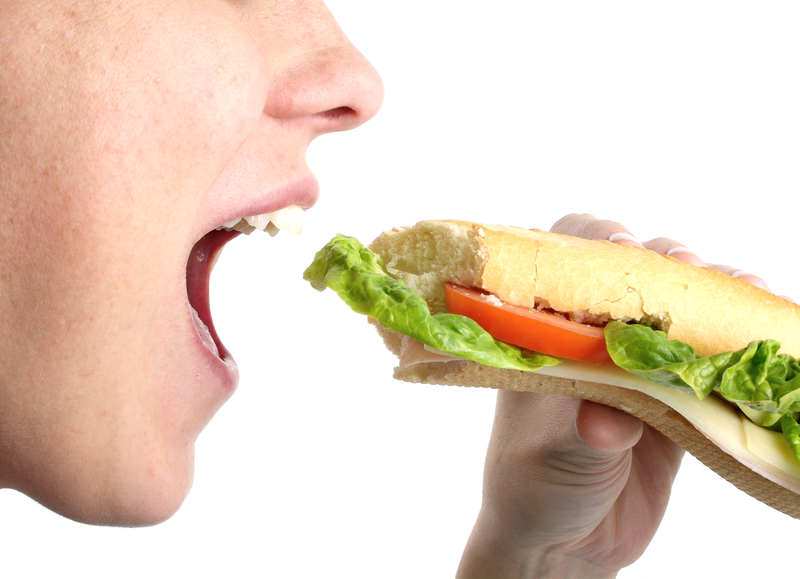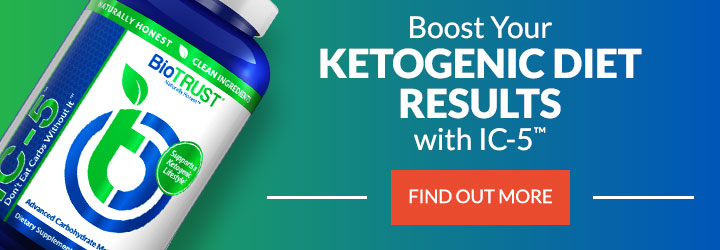Hunger Hormones Are Real. Here Are 11 Tips to Control Them

How many times have your weight-loss efforts been thwarted by an insatiable hunger? Have you ever successfully achieved your weight-loss goal only to gain it all back—and then some—thanks to what could only be described as a hunger gremlin? Have you ever wondered if your body is “broken” because no matter how hard you try, you can’t seem to be stronger than your hunger? You’re not broken, and it’s not a matter of willpower. While the abundance of the modern environment is certainly at play, we can’t deny that your body is designed to work against you and your efforts. Here are 11 tips to get your hunger hormones under control.
Your Body Is Programmed to Work Against You
As early as 1973, researcher Douglas Coleman hypothesized that there was a “satiety factor” that regulated calorie expenditure and intake—an “internal force,” if you will, that tells our brains when we’ve eaten enough and urges us to seek food when we haven’t.1
Upon its discovery in 1994, leptin, which comes from the Greek word leptos, meaning “thin,” became known as the “satiety hormone.”2 Leptin, a hormone produced by fat cells, is responsible for long-term regulation of energy balance (i.e., calorie intake and expenditure), and one mechanism it does so is by suppressing hunger.3
A perfect example of leptin’s role as an “anti-starvation” hormone is the body’s response to reduced-calorie diets. Simply put, leptin levels plummet with decreasing caloric intake. In fact, research shows that leptin levels can drop, on average, by 43 – 63% after just one week of calorie restriction.4 What’s more, because fat cells are responsible for the secretion of leptin, when you lose fat, leptin levels also drop, as you have less of the very tissue that produces this hormone.5
That’s a dual-pronged threat to achieving your weight-loss goals, but what exactly does this drop in leptin mean? Well, it’s important to point out that leptin is much more than just a “hunger hormone.” Leptin is charged with the responsibility of being an “energy-sensing” hormone.
Through a process called adaptive thermogenesis, the body is quite adept at making compensatory adjustments to help match calorie expenditure with calorie intake.6 In the face of dangerously low energy supplies and stores, this form of energy conservation is a biologically meaningful survival mechanism.7,8,9 However, in your quest for a leaner, sexier body, this means your body is programmed to work against you.
That’s right, the body does its best to fight even your best weight-loss efforts, and much of this opposition is thought to be mediated by declining leptin, which signals the following adaptations:9
- Decreased calorie expenditure
- Decreased non-exercise activity thermogenesis (i.e., NEAT)
- Decreased sympathetic nervous system tone
- Decreased thyroid hormone output
- Decreased reproductive hormone output
- Increased muscle efficiencies
- Increased parasympathetic nervous system tone (i.e., “rest and digest”)
- Increased hunger and activity of food reward systems
These compensatory adjustments can be summed up relatively briefly by stating that the body initiates a number of “energy preservation mechanisms” in an effort to reduce calorie expenditure and increase calorie intake. In other words, each of these adjustments either reduce how many calories you burn and/or drive the body to seek out more food—particularly calorie-dense, highly-palatable foods.
Ghrelin and Your Hunger Hormones
You may be starting to see the conundrum and how the body’s physiology is set up to work against weight-loss efforts, and one example of this in action can be seen with the “hunger hormone” ghrelin, which is leptin’s counter hormone.
Ghrelin is produced in the GI tract and functions primarily to stimulate the appetite.10 Along these lines, ghrelin is released when the stomach is empty, and levels go down after eating (particularly after eating proteins and carbohydrates, highlighting a potential association between insulin and ghrelin).11 In addition to stimulating hunger, ghrelin also “turns on” reward centers in the brain, increasing the pleasure and reward response to eating and reinforcing the consumption of calorie-dense, highly palatable food.12–14
Not surprisingly, studies also show that levels of ghrelin steadily increase with weight loss, a change that corresponds with the simultaneous drop in leptin levels. In that sense, these two hunger hormones work in tandem to combat starvation and weight loss.
And Now…The Rest of the Hunger Hormones Story
While the hunger hormone story typically revolves around leptin and ghrelin, they are certainly not the only hormonal regulators of appetite. In fact, there’s a whole cast of hormones that regulate appetite—both satiety and hunger—and it’s not a stretch to say that we don’t even know all the players just yet. Just so you can appreciate how intricate the story is, here’s a list of the key appetite regulators:15–17
- Hunger Hormones (stimulate hunger/feeding):
- Neuropeptide Y (NPY is produced in the hypothalamus region of the brain)
- Agouti-related peptide (AgRP is produced in the hypothalamus region of the brain)
- Ghrelin (produced largely in the stomach; the only peripheral hormone that stimulates hunger)
- Satiety Hormones (inhibit hunger/feeding):
- Pro-opiomelanocortin (POMC/α-MSH is produced in the hypothalamus region of the brain)
- Cocaine- and amphetamine-regulated transcript (CART is produced in the hypothalamus region of the brain)
- Cholecystokinin (CCK is produced in the small intestine)
- Peptide YY (PYY is produced in the small and large intestines)
- Pancreatic polypeptide (PP is produced by the pancreas and colon)
- Oxyntomodulin (OXM is produced in the small and large intestines)
- Glucagon-like peptide 1 (GLP-1 is produced in the small and large intestines)
- Glucose-dependent insulinotropic polypeptide (GIP is produced in the stomach and small intestine)
- Insulin (produced by the pancreas)
- Leptin (produced by fat tissue)
- Adiponectin (produced by fat tissue)
When it comes to all of these hunger hormones, you don’t necessarily need to remember the alphabet soup—although it makes for pretty interesting party conversation. However, what is important to recognize is the hunger hormone story is complicated.
- The brain, gut, fat tissue, and pancreas all secrete key hormones that regulate appetite.
- There are more satiety hormones than hunger hormones; in other words, there are more hormones that inhibit hunger than those that stimulate it.
- As sexy as the story may be, there’s not one single hormone that does it all. In other words, it doesn’t make sense to hone in and isolate a single hormone as the so-called bad guy.
- And even the hungriest of hormones typically serves multiple functions.
For example, ghrelin, which has earned the scarlet letter as the hunger hormone, actually goes by another name: growth-hormone releasing peptide. That’s right, ghrelin stimulates the release of growth hormone.18
And as you may know, growth hormone is known as a key anti-aging hormone, and it increases fat breakdown and use, protein synthesis, bone density, and skin thickness.19 And many attribute reduced growth hormone to decreased energy levels. Simply put, there’s usually more to the story than we think—or are led to believe.
Perhaps one of the biggest take-home points is that the complexity of the hunger hormone story is yet another illustration of how complicated the weight-management puzzle can be. In other words, if you struggle to lose weight and keep it off, this is more evidence that it’s not your fault.
The human body is wired to defend against one-size-fits-all societal ideals and labels. Even more, we’ve talked about nutritional genetics and how individual differences apply, and appetite is no different. For example, we now know a variant of the FTO gene (which is known as the fat mass and obesity-associated gene, or more simply as the “fat gene”) is linked with higher levels of the hunger hormone ghrelin and lower levels of the satiety hormone leptin.20
11 Tips to Harness Your Hunger Hormones
Tip 1: Slow down and chew your food.
Surely you’ve heard this a time or two, but did you know that eating slowly can have a tremendous impact on feelings of fullness and hunger? Slow eating increases levels of the satiety hormones GLP-1 and PYY and decreases levels of the hunger hormone ghrelin. Studies show that chewing each bite of food about 40 times (as opposed to 10 or even 25 times) and slowly enjoying a meal over the course of about 30 minutes are strategies likely to have the greatest impact on appetite.21,22
Tip 2: Chew gum.
It seems like the act of chewing itself promotes satiety by influencing appetite, hormone release, and hunger. In fact, studies have shown that chewing gum can increase feelings of fullness, suppress hunger, reduce the desire to eat—including the desire to eat sweet snacks—and decrease overall caloric intake.22 Since most gum contains a laundry list of artificial chemicals, be mindful of what you put in your mouth. Look for an all-natural chewing gum that’s free from synthetic ingredients.
Tip 3: Eat carbs at night.
Say what?! That’s the worst time to eat carbs, you say? I don’t know about that, especially if you’ve exercised during the day or even if you take a walk after dinner, both of which can improve glycemic variability and how the body uses those carbs. There’s some evidence that eating a significant portion of your daily carbs (assuming healthy choices, of course) at dinner can lead to improved profiles of several hormones related to hunger and satiety, including leptin, ghrelin, and adiponectin.23 In my experience, this works very well for managing hunger and cravings and increasing overall compliance.
Tip 4: Power up with protein.
While “backloading” with carbs can be an effective dietary strategy for managing appetite, there’s one more that may be even more powerful. A higher-protein diet has consistently been shown to be an effective tool for weight management, and while there are a couple explanations, one of the strongest is the positive impact protein has on satiety. Protein-rich foods tend to increase levels of appetite-suppressing hormones (like CCK, GIP, GLP-1, and PYY) and reduce concentrations of the hunger hormone ghrelin. Generally speaking, a good protein target is around 0.7 grams per pound per day, although there are various factors that can influence how much protein is optimal.
Tip 5: Skip meals.
This one may seem a little counterintuitive, but skipping meals may help regulate appetite. On one hand, the hunger hormone ghrelin appears to be trainable. In other words, the stomach secretes ghrelin on a schedule that aligns with the times you normally eat and in anticipation of eating.24,25 Along those lines, you may not really be hungry; your body may just be used to getting food. By skipping a meal here and there, you put yourself—not your hormones—in the driver’s seat. Intermittent fasting (IF) is one way to put this into practice, and research shows that various IF protocols—such as time-restricted feeding and alternate-day fasting—may improve appetite regulation.26,27
Tip 6: Exercise.
Most people think—and say—exercise increases appetite, but in my experience, this has more to do with hedonic compensation than actual increases in appetite. In other words, we often reward ourselves for being active by (over)consuming food, and more often than not, we rationalize our overeating and indulgence in junk food with exercise. While the impact of exercise on appetite does vary from person to person, there’s little scientific evidence that exercise actually makes people hungrier. In fact, experiments often reveal that exercise reduces appetite.32,33
Tip 7: Take a walk.
While you could argue that the “best” time to exercise is whenever you can make time, exercising after eating can increase satiety and improve glycemic control.34,35 In fact, taking a 20-minute walk after dinner is more effective at improving glycemic variability (think managing blood sugar) than taking a walk before a meal.36
Tip 8: Lift weights.
There’s a big difference between weight loss and quality weight loss, which emphasizes shedding excess body fat (especially belly fat) while maintaining (or even better, increasing) calorie-burning lean muscle, which has functional and metabolic significance. This is really important because losing lean muscle—which is a common, expected side effect of typical weight-loss diets—leads to:
- Decreased metabolic rate
- Greater likelihood of weight regain
- A host of potential negative health consequences
- Increased appetite.
While weight loss typically leads to a proportional increase in appetite, researchers believe that losing muscle drives hunger, appetite, and overeating—a phenomenon known as collateral fattening.37,38 When it comes to protecting calorie-burning muscle, the two keys are:
- Optimizing protein intake
- Lifting weights
Along those lines, it’s a good idea to lift weights (exercising each of your major body parts) 2 – 3 times per week emphasizing “compound movements,” like squats, presses, and rows.
Tip 9: Try keto.
The keto diet is hotter than a tea kettle these days, and it is becoming increasingly popular as a weight-loss diet. One reason it can help with weight loss is that ketone bodies may directly suppress the appetite.28 For example, a recent review study published in the journal Obesity Reviews found that the ketogenic diet suppresses appetite, reduces hunger, increases satiety (feelings of fullness and satisfaction).29 Additional studies have shown that the ketogenic diet reduces levels of the hunger hormone ghrelin and increases levels of satiety hormones, such as CCK.30 And interestingly, one study showed that the keto diet prevents the increase in appetite normally experienced with weight loss.31
Tip 10: Get low. Energy density refers to the relationship of the caloric content of a food relative to its weight (i.e., calories per gram of food). When you choose low-energy-dense foods (LEDF), which typically have high water and fiber content, you can eat more food. That’s key because one of the most important factors in making you feel full (satiated) and cueing you to stop eating is food volume. Along those lines, diets rich in LEDF typically result in greater satiety and lower caloric intake. Low-energy-dense diets lead to better hunger hormone profiles (e.g., less ghrelin, more PYY), and these improvements in appetite control are sustainable after weight loss.39,40 The best examples of LEDF are fruits and veggies, and whole grains, legumes, lean meats, and dairy are also LEDF. In other words, this is a fancy way of saying you should eat more colorful fruits and vegetables.
Tip 11: Sleep. Want a surefire way to jack up your hunger hormones and increase your appetite? Don’t get enough sleep. There’s no question that lack of sleep increases appetite, particularly for high-carb, high-fat junk foods. Interestingly, sleep deprivation amplifies the release of naturally-occurring endocannabinoids, which bind to the same receptors as the active ingredient in marijuana. This increase in endocannabinoids, of course, results in a greater desire to eat highly palatable foods—also referred to as the munchies.41 Sleep deprivation has also been shown to suppress levels of leptin and elevate ghrelin levels. As mentioned above, this hormonal cascade leads to a surge in appetite, and it also makes normally tasty junk foods even more palatable. Besides messing with your hunger hormones, sleep deprivation also goes hand-in-hand with staying up late, and the more hours you’re awake, the more food you’re going to eat. It’s as simple as that: Sleeping less means increased caloric intake.42 Of course, we all know what types of foods people reach for at those late hours—high-calorie junk food.
How to Control Your Hunger Hormones: A Recap
While hunger hormones are very real, there are many reasons we crave and eat food. For example, our food environment and the people we spend our time with can have tremendous influence on what and how much we eat. So, while these 11 tips to control hunger hormones offer a solid blueprint to appetite management, be mindful of why and how you eat.







